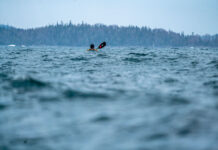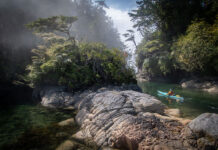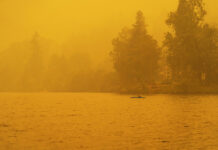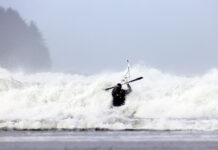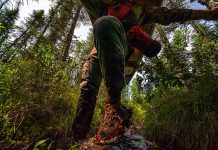My favorite weekend getaway is a gorgeous island, just a 90-minute drive and a short paddle from my front door. There are sweet grassy fields, basalt cliffs, sand dunes, wildflowers, and pictographs. I play in the rock islands for hours and hike to the top of the cliffs for a stunning view of a sunset or sunrise. Over the years I have happily availed myself of the free camping sites scattered around the island.
I can’t camp there anymore. Four years ago the U.S. Forest Service closed the island to camping. When I asked them why, their answer made sense to me: the grassy island is vulnerable to fire, home to Native American pictographic sites, and a difficult place for the Forest Service to patrol and clean up.
Is free camping coming back into vogue?
For the past several years, there’s been an ebb tide where paddlers are allowed to camp without reservations, permits or prescribed tent spots. But that tide may be turning.
At a recent gathering at a Denver REI store, Tinelle Bustam, the U.S. Forest Service’s Assistant Director of Recreation, said, “We have a strange tendency of gearing toward no than gearing toward yes. We want to pivot from no and toward yes.” The crowd of climbers, paddling guides, outdoors groups, anglers, and mountain bikers cheered.
I’m a longtime wilderness traveller. Probably like you, I love free-range camping. Get tired, find a protected cove or a beach with a good view and pull over. It’s the perfect expression of love for wilderness, discovery, freedom and self-contained nomadic movement through nature. It’s our gift from humanity’s earliest ancestors.
Having to paddle to a designated campsite to comply with permits or rules is as much fun as headwinds on mile 17.
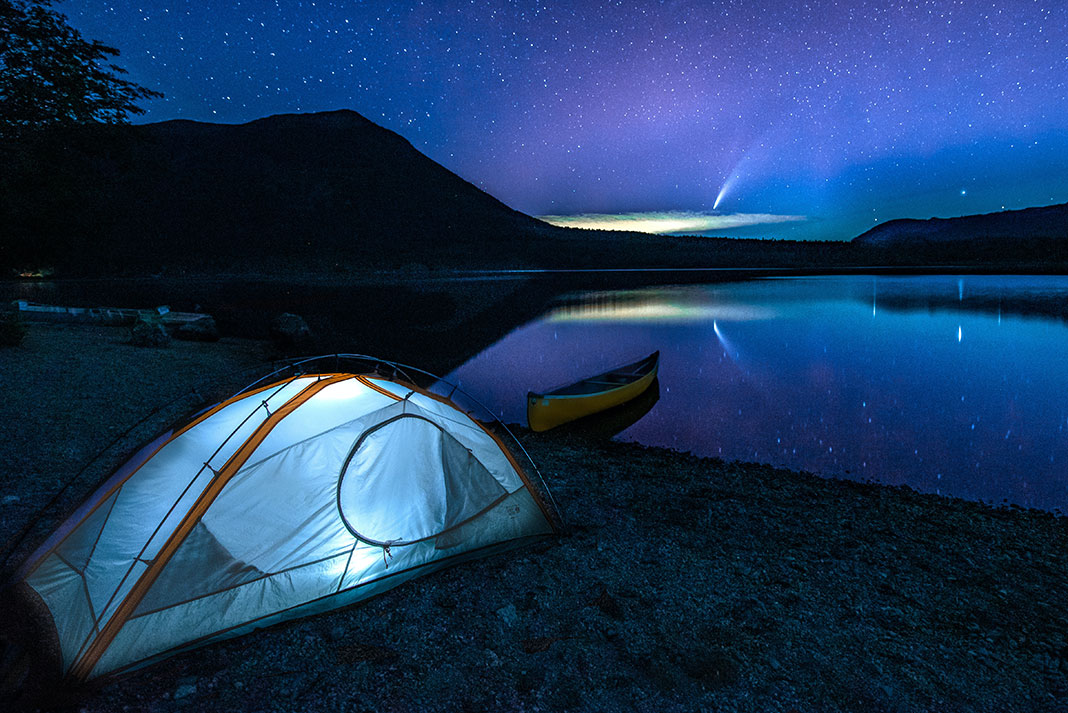
It’s not that easy to provide free camping
Let’s face it: unregulated camping only works when we have three things:
- Lots of land and small numbers of people that can spread out across it.
- Users who are good stewards and manage their impact.
- Enough resources so that whoever’s in charge knows if the place is being damaged so they can step in and restore it.
Right now, we don’t have enough of the first and third requirements to meet demand.
Following the herd
As of 2010, 81 percent of the North American population live in urban areas. People pour out of cities on weekends and overwhelm the wild places closest to them. Put-ins and trailheads in proximity to urban centers are mobbed, while others just slightly further go unused. We’ve become creatures of habit, using the same places over and over again and largely ignoring the rest.
On a recent weekend, I crawled past a trailhead traffic jam that reminded me of the approach to Manhattan’s Holland Tunnel. Two miles further down the highway, a similar trailhead parking lot was totally empty. Logs had fallen across the trail. The Forest Service hadn’t cleared them: the rangers probably figured it wasn’t used enough to justify sending someone out to saw trees apart for two or three days. The solitude was great, but it also made me sad.
As adventurers, we love poring over maps and charts to find cool new places to paddle or hike. Google Earth makes this kind of exploration more accessible than ever, but most people seem content just following the herd. It may seem like a good idea to open more wilderness areas to free-range camping. But I’m not convinced.
Permits work to protect wildlife
When people can’t—or won’t—spread over a wide area, the concentration strategy makes sense. Permits and limited access to a few areas create a few small areas of intense impact—and let nature reign everywhere else.
Think of the few accessible campsites on Barkley Sound’s Broken Group Islands or the way campsites on Idaho’s Middle Fork of the Salmon are pre-negotiated between groups. Annoying if you’re a human, but Barkley Sound is great if you’re a wolf or a bear.
Cashed-strapped agencies, charged with keeping vast acreages of wild places wild, have often used this strategy. The other choice is to try to patrol vast areas and fail.
Nature untrammeled
Even intensely popular places like the Grand Canyon or Glacier Bay, for the lucky permit-getters, feel just like the U.S. Wilderness Act states, “Where the earth and its community of life are untrammeled by man, where man himself is a visitor who does not remain.”
Given the job of managing priceless places that are easy to destroy and hard or impossible to restore, saying “no” follows the most basic rule of dealing with nature: do no harm. We just don’t like it when we’re the one who was too slow to snag a campsite.
Free camping requires time and money
Opening up more places to free camping will only work if we give agencies enough people and money to monitor their—I mean our—vast holdings and keep tabs on sites that are getting damaged. And we haven’t done that. In an era of budget cuts, the likely outcome of saying yes more often is likely to be lose-lose. Most of us will still have to deal with crowds at popular spots. And when we venture into the unregulated wilderness, we’re likely to find impacted camping areas, trash, and poorly buried wads of toilet paper.
Between infrequent patrols and cleanups, the Tragedy of the Commons will creep in, unnoticed, like a rising tide. When there are enough rangers and ecologists to keep things shipshape, more unfettered access sounds great. Until then, better safe than sorry when it comes to free camping for paddlers.
This article was first published in Issue 51 of Paddling Magazine. Subscribe to Paddling Magazine’s print and digital editions, or browse the archives.



